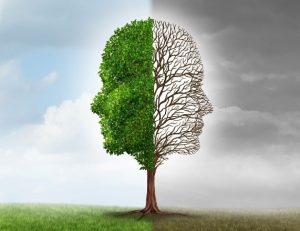Bipolar Disorder
According to Statistic Brain, 2017 there are 5.8 million adults that are currently diagnosed with bipolar disorder in the US. It usually starts to affect people by the age of 25 years old. Bipolar disorder, also known as manic-depressive disorder, is a mental health condition that causes unusual shifts in mood, energy, activity levels, and the ability to carry out day-to-day tasks. There are two types of moods that occur with this disorder. They are known as manic and depressive episodes. Manic episodes occur when someone is irritable, feeling jumpy, or feeling very elated. When people are down and feeling hopeless this is when the mood is depressive.
The four types of bipolar disorder that involve these severe changes in mood are Bipolar I Disorder, Bipolar II Disorder, Cyclothymic Disorder, and Specified and Unspecified related disorders. Bipolar I Disorder is defined by manic episodes that last at least seven days. Depressive episodes also occur typically lasting for at least two weeks. Bipolar II Disorder is a pattern of depressive episodes and hypo-manic episodes, but not like the manic episodes described above. Cyclothymic disorder is defined by numerous periods of hypo-manic symptoms as well as numerous periods of depressive symptoms lasting for at least two years. However these symptoms do not meet the diagnostic requirements for a hypo-manic episode and a depressive episode.
In some cases, a mood episode includes both manic and depressive symptoms. When this happens, it is known as mixed features. A person could feel sad, empty, and energized at the same time. Some people with bipolar disorder can experience hypo-mania. It is a less severe form of mania. During an episode of hypo-mania, a person can be functioning well and feel very good without knowing that something is wrong with them. Family and friends can sometimes recognize the mood swings or changes as possible bipolar disorder. If they do not have proper treatment, people with hypo-mania could develop severe mania or even depression.
With proper diagnosis and treatment, people with bipolar disorder can live healthy and productive lives. The first step someone will need to take is talking to a doctor or other licensed mental health professional. If the problem is not caused by other illnesses a doctor should refer you to someone who can diagnose and treat bipolar disorder such as a psychiatrist. Bipolar disorder may be a lifelong illness; however, it can be kept under control. An effective treatment plan usually includes a combination of psychotherapy and medication. Psychotherapy can provide support, education, and guidance to people with bipolar disorder and their families. It is also good for a client to keep a record of their everyday moods. They should track symptoms, treatments, sleep patterns, and life events. This allows the client and the doctor to track and treat the disorder more effectively. The medications that are used to help treat this disorder are mood stabilizers and antidepressants. In a case where someone cannot take the medication, other treatment is available.
By Brianna Nedd-Rice

